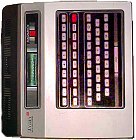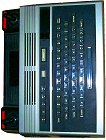 Introduced in 1972 after nearly four years of research, development and marketing, the Magnavox Odyssey was based on the Brown Box TV game prototype designed by inventor Ralph Baer. Baer had been working on devising a way to play interactive games on a television screen since 1966, and completed the Brown Box in 1968. The game was a simple table tennis game, though with an added “English” control which later variations on the same theme (i.e. Pong) omitted. Baer had originally designed a game of “tag” requiring only two player cursors, and also conceived several other variations on familiar games. By the time the Odyssey was released, it was no longer a dedicated ping-pong simulator, but included other games as well, accessible by inserting the right “program card” into a slot on the front of the Odyssey console. (While it’s tempting to call this the forerunner of cartridge-based video games, that would be a misnomer; all of the games were actually native to the Odyssey’s internal circuitry, and the cards merely acted as “keys” to tell the machine which variation of which game was being played.) Eager to parlay the excitement over Odyssey into sales of not only game consoles but television sets, Magnavox made a greedy blunder, leading the public to believe that Odyssey would work only on Magnavox television sets. Despite a successful launch (using none other than Frank Sinatra as a spokesman for Odyssey’s national TV debut), the Magnavox-only maneuver was costly; Odyssey was only in production for two years.
Introduced in 1972 after nearly four years of research, development and marketing, the Magnavox Odyssey was based on the Brown Box TV game prototype designed by inventor Ralph Baer. Baer had been working on devising a way to play interactive games on a television screen since 1966, and completed the Brown Box in 1968. The game was a simple table tennis game, though with an added “English” control which later variations on the same theme (i.e. Pong) omitted. Baer had originally designed a game of “tag” requiring only two player cursors, and also conceived several other variations on familiar games. By the time the Odyssey was released, it was no longer a dedicated ping-pong simulator, but included other games as well, accessible by inserting the right “program card” into a slot on the front of the Odyssey console. (While it’s tempting to call this the forerunner of cartridge-based video games, that would be a misnomer; all of the games were actually native to the Odyssey’s internal circuitry, and the cards merely acted as “keys” to tell the machine which variation of which game was being played.) Eager to parlay the excitement over Odyssey into sales of not only game consoles but television sets, Magnavox made a greedy blunder, leading the public to believe that Odyssey would work only on Magnavox television sets. Despite a successful launch (using none other than Frank Sinatra as a spokesman for Odyssey’s national TV debut), the Magnavox-only maneuver was costly; Odyssey was only in production for two years.
That year, however, saw the introduction of an expansion package (including the first-ever light gun) which added more games to the Odyssey, as well as one of the first video game industry lawsuits as Magnavox and Ralph Baer took Atari founder Nolan Bushnell to court over similarities between Odyssey and Pong, then just an arcade fixture. When it was revealed that Bushnell had attended an early Odyssey demonstration prior to the release of Pong, the case was pursued more vigorously until Atari agreed to pay a flat sum to Baer to avoid further infringement action. (Many years later, Baer felt that Bushnell and Atari got off the hook too easily.)
In its wake, Atari inked a deal with Sears for distribution of its own first home video game, the home Pong console. A bit less convoluted than Odyssey, Atari’s succession of Pong machines also offered less variety, sticking only to tennis-style games. But with Sears outlets nationwide selling the game, Pong met with more success than Odyssey, and continued to reinvent itself with minor variations for several months. Taking note of Atari’s success, Magnavox responded with its own even cheaper dedicated ping-pong game, Odyssey 100, in 1975. A self-contained unit – all game controls were confined the the console itself – Odyssey 100 didn’t even keep score, requiring players to do so with two score sliders built into the face of the console. It also offered players more choice than Pong, giving them the chance to play tennis or hockey (in reality, very minor variations on the same theme). And in a humorous show of overcompensating for its mistakes of the past, Magnavox fessed up that Odyssey 100 would display its B&W graphics on any television set – and said so loudly on every side of the box in which the unit was sold.
Odyssey consoles kept coming fast and furious for the next couple of years: the Odyssey 200 (1976) offered more play variations in an essentially identical casing (though molded in white instead of the Odyssey 100’s bright orange); Odyssey 300 introduced on-screen scoring and did away with the sliders (wow!); Odyssey 400 was a curious backward step to the analog three-knob controls; and Odyssey 500 did away with boxes and blips, drawing stick-figure tennis players – with rackets, no less! – on a green court. (The barely-anthropomorphic figures were eerily similar to those displayed by the Odyssey2’s fixed character chip a few years later.)
In 1977, Odyssey 2000 was the last to use the standard Odyssey casing that had been receiving different paint jobs since ’75, repeating Odyssey 300’s simplification of the controls down to a single knob. Odyssey 3000 was the high water mark of the Odyssey line with its sleek black console, while Odyssey 4000 turned the rotating paddles into actual joysticks (nearly identical to the future Odyssey2 controllers).
As 1978 loomed, Magnavox designed and began creating advertising for a sleek new four-player console, Odyssey 5000, boasting 24 built-in games that would include car racing and tank battles. A machine very similar to the 5000, the Odyssey 2100, hit stores in Europe, but as the time to put the new machine into production drew closer in the U.S., several things happened that brought the Odyssey dedicated console series to a halt. Fairchild and Atari had recently put the first programmable consoles – featuring interchangeable program cartridges – on the market, and though the new machines (the Channel F and Atari’s Video Computer System weren’t exactly a runaway success, it was clear that the paradigm in home video gaming had permanently shifted.
It was also – thanks to technology and science fiction enjoying mainstream attention through Star Wars, and computers going mainstream by way of such machines as the Apple II – a time of unprecedented consumer savvy where computer-related products were concerned. Even if the Odyssey 5000’s 24 built-in games were fun, the machine had a limited life span and would almost certainly be passed up by consumers looking for programmable systems with more variety.
Magnavox eventually decided to scrap the Odyssey 5000 and start from scratch with its own cartridge-based system. The design of the console itself was salvaged, with the recessed area holding the four joysticks being turned instead into a keyboard, and the joystick design itself was carried over. A second, smaller recessed area on the Odyssey 5000 console schematic became the home of a cartridge slot and a power button. And late in 1978, the Odyssey2 was born.
Click on any of the consoles below for more detailed discussions of that particular model’s games and features, complete with photos and real live non-emulated screen shots.










